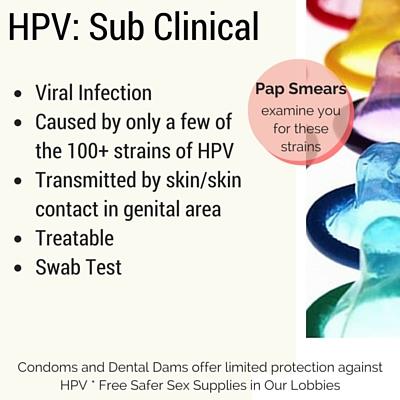HPV - Sub Clinical

HPV - Sub Clinical
Some types of the Human Papilloma Virus are spread by sexual contact, which is why HPV is considered a sexually transmitted infection. These types of the virus cause warts that appear on the genitals (vagina, vulva, penis etc.) and anus of women and men. Some of the types that are sexually transmitted cannot be seen and have no symptoms. These are the types of the virus that infect the cervix (the cervix is located in a woman's vagina and is the opening to the uterus) and cause women to have abnormal pap smears.
The Centers for Disease Control estimates that there are currently 20 million men and women infected with HPV that is sexually transmitted and 5.5 million new cases each year, making HPV the most common sexually transmitted infection in the United States. Despite the fact that the HPV virus has been around for hundreds of years, little was understood about the types of the virus, which infect the genitals including the cervix. In the last few years, researchers have begun to understand the virus better.
Women usually discover that they have sub clinical HPV when they have a pap smear with abnormal results.
Symptoms
Unless you have visible genital warts you cannot tell that you have HPV. The types of HPV that do not have any symptoms are called sub clinical. Sub clinical means that you cannot see warts and that you have no recognizable symptoms.
What Are The Health Problems Associated With HPV - High Risk Strains?
- In women and trans men, HPV can cause changes on the cervix. Typically, the body clears up any abnormal cells. If left unchecked, the cells may become cancerous.
- HPV can affect the anus and throat.
Confidential Testing
Recently a test specifically for women has become available which can differentiate between the types of HPV. Men have sub clinical HPV too, but the test for HPV does not work for men, so men with sub clinical HPV rarely know it.
Treatment
HPV is a common sexually transmitted virus that can cause genital warts. There are over 30 known strains of HPV. Sometimes, if a woman has contracted the virus it can cause a pap smear to return with "abnormal" results. This is not an indication of cervical cancer. It simply means that the HPV has caused some of the cervical cells to change. In most women, over a period of 12-24 months, the cells will return to normal on their own, with or without treatment. If you have an abnormal Pap smear, information about your options is available from Women's Health Specialists. The incidence of cervical cancer in the US is about 15 per 100,000 women, relatively low, as compared to 140 per 100,000 incidences of breast cancer, according to the National Cancer Institute.
In June of 2006, the FDA approved a vaccine developed by Merck Laboratories. The vaccine, named Gardasil, is recommended for use in women ages 9-26. Currently, there is no evidence that the vaccine will prevent HPV or cancer. The FDA is concerned that there has not been sufficient time to track long-term outcomes and side effects of the vaccine, potential birth defects, a possible worsening of HPV in women who already have the virus, and possible complications due to allergies or exposure to the vaccine itself.
For more information on HPV vaccine, click here.
As with any vaccine, it is important to weigh the risks and benefits to you before consenting to receive it. General vaccine information is available at:
The National Vaccine Information Center
www.909shot.com
The Center for Disease Control's National Immunization Program/Risks and Benefits Information Sheets:
Test Your Knowledge
1. True or False: A person of any gender can give sub clinical HPV to a person of any gender.
2. True or False: Sub clinical HPV is transmitted via skin/skin contact.
3. True or False: Typically, the body naturally clears up HPV.
4. True or False: If you're have anal, vaginal or oral sex, the only way to know if you've been exposed is to get tested.
5. True or False: Most people will have a sexually transmitted infection during the course of their lifetime.
All True!